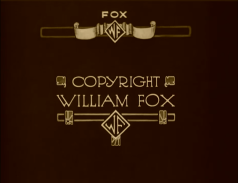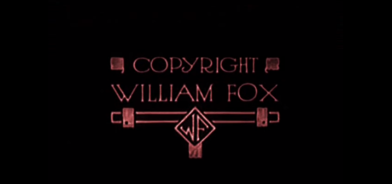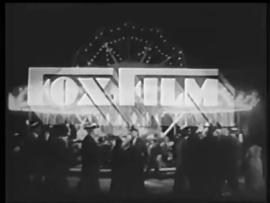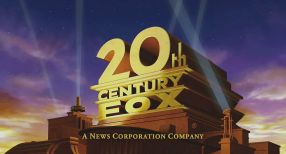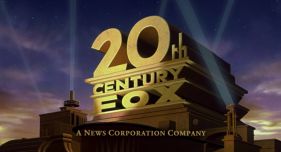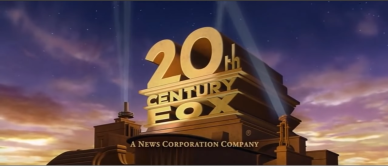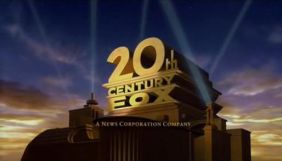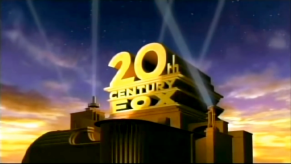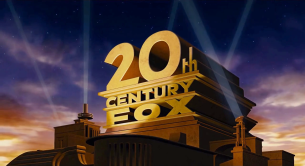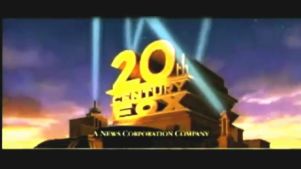20th Century Studios
Jump to navigation
Jump to search
Logo descriptions by Matt Williams, Kylejaker1988, and Hb1290
Logo captures by V of Doom, Eric S., Logoboy95, and others
Editions by Eric S., iheartparamount, V of Doom, Nathan B., Donny Pearson, Chowchillah, Betamaxtheflyer, Shadeed A. Kelly, DaBigLogoCollector, Muzzarino, GoAnimateFan199Pro, and BoyOnTheMoon
Video captures courtesy of simblos, Logic Smash, Peakpasha, BreadCrustCouncil, Jordan Rios, news5aksionfan661, galaxyOG, VideoEffects666 HD, - VPJLogo -, licerin91, WorldIntroHD, The Alifexable Creed, and Pepsi9072
Fox Film Corporation
1st Logo
(September 13, 1915-November 28, 1935)
Logo: The in-credit text of Fox Films. It would just say:
In other cases, it mentioned the name of William Fox:
FX/SFX: The simple fade in and fade out.
Music/Sounds: Silent, or the film's opening music.
Availability: Very rare. Can be seen on Sunrise (1927) and other films of the era, but most just a contain a "Fox Films" notice in the credits sequences. Occasionally appears on films shown on TCM's Silent Sunday Nights or on Fox Movie Channel, but showings on the latter have been scarce to none. The logo premiered on Regeneration and made its final appearance on In Old Kentucky.
Editor's Note: None.
2nd Logo
3rd Logo
(1929?-1933?)
Logo: Over the final frame of a film, we see a long "F" wiping in. Then, "OX" appears letter-by-letter. At this point the background fades into a black screen. Another long "F" wipes in, and "ILM" appears letter-by-letter. A trail appears behind the letters. The entire text is in a weird font.
Variant: A superimposed still version exists.
_______________________________________________________________
20th Century Pictures, Inc.
Background: Twentieth Century Pictures, Inc. (also known as "20th Century Pictures, Inc.") was an independent Hollywood motion picture production company created in 1932 by Joseph M. Schenck, the former president of United Artists, Darryl F. Zanuck from Warner Bros. Pictures, William Goetz from Fox Film Corporation, and Raymond Griffith. Their material was released theatrically under United Artists.
(October 7, 1933-April 17, 1936)
Nicknames: "The Searchlights", "Futuristic Structure", "Majestic Tower", "Pre-Fox Structure"
Logo: On a dark sky background, 3 rows of words, "20th","CENTURY", and "PICTURES, INC.", apparently carved out of stone and/or metal, are seen. The words are "stacked" on top of each other, with similarly carved lines separating the rows. The "20th" is the biggest row, with "CENTURY" and "PICTURES, INC." a bit smaller. A circular stage-like structure juts out from the base of the "stack," with a light below the structure that shines in front of the "stack". There are pedestals on both sides of the stack, each with a non-moving searchlight. In the background, several searchlights scan the sky. This logo was designed by Emil Kosa, Jr. The logo was created as a painting on several layers of glass and animated frame-by-frame.
Closing Title: Superimposed on a special background or sometimes on the last scene of a movie, fade in the words "The End" with fonts that vary on different movies with the following closing texts: "A 20th Century Picture" and below in a smaller font "Released Thru United Artists".
FX/SFX: The searchlights in the background.
Music/Sounds: A marching drum intro leading into a 21-note full orchestra theme that ends with a horn flourish. The fanfare was composed and conducted by Alfred Newman. On some films, the 1st drum roll is cut off due to whatever surviving audio elements were used on the film print.
Music/Sounds Variants: There were a couple of re-recordings of the fanfare that were different than the later re-recording used in the TCF logo. One of the two was used on 1935's Les Miserables and The Call of the Wild.
Availability: Until recently, this logo was on the verge of extinction due to chronic plastering by any of the 20th Century Fox logos. Seen on streaming prints of The Bowery, the Cinema Archives DVD-R of Clive of India, and TV airings of The House of Rothschild along with Blood Money whenever they air on TCM or the Fox Movie Channel Block on FXM. The logo premiered on The Bowery and made its final appearance on Folies-Bergère. Although most prints of The Call of the Wild (1935) have this plastered with the 1953 logo, this has recently resurfaced on the Blu-Ray release (since it uses a new restoration).
Editor's Note: The first appearance of the Fox identity, even though it wasn't even Fox yet. If you pay close attention in the background, there are two searchlights that bend, which is considered to be an impossible phenomenon.
_______________________________________________________________
20th Century Fox Film Corporation
Background: In 1935, Twentieth Century Pictures, Inc. and Fox Film Corporation merged together to form "Twentieth Century-Fox Film Corporation" (the hyphen between "Century" and "Fox" was dropped in 1985), or simply "20th Century Fox". From 2013-2019, it was a subsidiary of 21st Century Fox Inc., which was a company formed when News Corporation split up into two companies. As of July 2018, their two most financially successful films are Avatar, released in 2009, and Titanic (under international rights), released in 1997. Both films were directed by James Cameron. Fox's most highly acclaimed film, according to review aggregator website Rotten Tomatoes (jointly owned by Universal and Warner Bros.), is All About Eve, released in 1950 and directed by Joseph L. Mankiewicz.
Variants: The Fox logo has had many renditions over the years. Here are some of them:
Music/Sounds:
Editor's Note: The tilted zero can be an eyesore to look at for some, but it's still a majestic logo.
3rd Logo
(August 28?, 1981-August 5, 1994)
Logo: Another redrawn version of the last logo. This time, the structure is as off-center left as the late 1960s variant of the 1953 logo. This logo was designed when Rocky Longo repainted the eight-layered glass panels, and straightened the zero. This design of the logo still continues to this day (albeit in a slightly modified form).
Variants:
Editor's Note: A return to the more accurately drawn Fox tower. This would serve as a template for the next logo below.
4th Logo
(July 15, 1994-October 5, 2010, March 30, 2013)
Nicknames: "CGI Searchlights", "Ultra Majestic Tower", "The Searchlights V", "Futuristic Structure", "Majestic Tower V", "Futuristic Structure V", "Fox Structure IV"
Logo: We start on a black background. Then two searchlights swoop across the screen, revealing a top aerial view of the 20th Century Fox structure, redone in CGI. The camera pans down and then across the logo, revealing the starry and cloudy blue/purple/orange Los Angeles and Hollywood evening skyline in the distance, before settling into its more customary position and angle. The byline "A NEWS CORPORATION COMPANY" fades in at the bottom of the screen. The structure looks similar to the 1981 logo.
Trivia:
Logo: It's a redone and more realistic version of the 1994 tower. This time, it is in a dark/orange evening environment. When the structure is in its distance, we can see an extra searchlight and a pair of palm trees on the bottom right hand corner. This structure, like the 1994 structure, also looks similar to the 3rd logo. This logo was designed by Chris Wedge and Carlos Saldanha and was animated at Blue Sky Studios, 20th Century Fox's sibling company and creator of Ice Age.
Trivia: This logo debuted on a trailer for Avatar on August 20, 2009 for the very first time. Afterwards, the logo first appeared on the aforementioned film, released on December 18, 2009 (though earlier premiering in London on December 10, 2009). Like the previous logo, if one looks very close in the far right-hand corner before approaching the main structure, one can see the Hollywood sign (not very big, but still visible if one looks hard enough). One can also see stars at the end of the logo, but there are fewer than the previous logo. The "Celebrating 75 Years" variant for TCF's 75th anniversary is a well done contemporary throwback of--and a contemporary homage to--the 20th Century Fox CinemaScope logo, where the 20th logo faded after 10 seconds into the CinemaScope logo. Surprisingly, this has made an appearance on a season 3 episode of This Is Us.
Background: In December 2017, Disney announced its plans to buy most of 21st Century Fox's assets, which included a bidding war with Comcast; the acquisition process was completed on March 20, 2019, with the last pre-Disney release from the studio being Alita: Battle Angel, released on February 14, 2019. The remaining assets Disney didn't acquire, notably the Fox network and Fox News, were spun-off into a new company called Fox Corporation. In January 2020, Disney announced that it would be dropping the word "Fox" from the company name, presumably to avoid confusion with Fox Corporation, renaming it as "Twentieth Century Studios." However, the studio is still legally incorporated and traded as 20th Century Fox.
Logo captures by V of Doom, Eric S., Logoboy95, and others
Editions by Eric S., iheartparamount, V of Doom, Nathan B., Donny Pearson, Chowchillah, Betamaxtheflyer, Shadeed A. Kelly, DaBigLogoCollector, Muzzarino, GoAnimateFan199Pro, and BoyOnTheMoon
Video captures courtesy of simblos, Logic Smash, Peakpasha, BreadCrustCouncil, Jordan Rios, news5aksionfan661, galaxyOG, VideoEffects666 HD, - VPJLogo -, licerin91, WorldIntroHD, The Alifexable Creed, and Pepsi9072
Fox Film Corporation
Background: The Fox Film Corporation was an independent film production company that was formed in 1915 by the theater "chain" pioneer William Fox. Fox formed Fox Film Corporation by merging two companies he had established in 1913: Greater New York Film Rental, a distribution firm, which was part of the independents; and Fox (or "Box", depending on the source) Office Attractions Company, a production company.
1st Logo
(September 13, 1915-November 28, 1935)
Logo: The in-credit text of Fox Films. It would just say:
FOX---FILM
PRESENTS
PRESENTS
In other cases, it mentioned the name of William Fox:
WILLIAM-FOX
PRESENTS
PRESENTS
FX/SFX: The simple fade in and fade out.
Music/Sounds: Silent, or the film's opening music.
Availability: Very rare. Can be seen on Sunrise (1927) and other films of the era, but most just a contain a "Fox Films" notice in the credits sequences. Occasionally appears on films shown on TCM's Silent Sunday Nights or on Fox Movie Channel, but showings on the latter have been scarce to none. The logo premiered on Regeneration and made its final appearance on In Old Kentucky.
Editor's Note: None.
2nd Logo
(1915-1917)
<iframe frameborder="0" height="186" src="http://wikifoundrytools.com/wiki/closinglogos/widget/unknown/5faf4ad0f935b129ac46f65b4db02f5cc7aeff47" width="247"></iframe>
.
Logo: We see the word "COPYRIGHT" in a slightly curly serif font with two shapes on either side to make it look like a ribbon or banner, below that we see "WILLIAM FOX" in the same font but larger letters, below that we see an abstract "T" like shape with a diamond and the letters "WF" in a diamond shape.
FX/SFX: None.
Music/Sounds: Silent, or the film's opening music.
Availability: Ultra rare, the video above comes from A Tale of Two Cities and it was also seen on <a href="https://youtu.be/Eq02ndFO5gE?t=4336" target="_self">Regeneration</a>.
Editor's Note: None.
3rd Logo
(1929?-1933?)
<iframe frameborder="0" height="184" src="http://wikifoundrytools.com/wiki/closinglogos/widget/genericvideo/c63a9dda4cfca6f08967e37025fbe02938f38a10" width="246"></iframe><iframe frameborder="0" height="184" src="http://wikifoundrytools.com/wiki/closinglogos/widget/genericvideo/b67aab941a5cd27cdfdc8947f1b9afb912867610" width="328"></iframe>
Logo: Over the final frame of a film, we see a long "F" wiping in. Then, "OX" appears letter-by-letter. At this point the background fades into a black screen. Another long "F" wipes in, and "ILM" appears letter-by-letter. A trail appears behind the letters. The entire text is in a weird font.
Variant: A superimposed still version exists.
FX/SFX: The wiping and appearing letters, and the changing background.
Music/Sounds: The ending theme to the film.
Availability: Ultra rare. The superimposed version can be found on Hoopla.
Editor's Note: The first actual logo used for this company. The design resembles the Art Deco design trend of the late 20s-early 30s.
20th Century Pictures, Inc.
Background: Twentieth Century Pictures, Inc. (also known as "20th Century Pictures, Inc.") was an independent Hollywood motion picture production company created in 1932 by Joseph M. Schenck, the former president of United Artists, Darryl F. Zanuck from Warner Bros. Pictures, William Goetz from Fox Film Corporation, and Raymond Griffith. Their material was released theatrically under United Artists.
(October 7, 1933-April 17, 1936)
20th Century Pictures Inc. 1935<iframe frameborder="0" height="186" src="http://wikifoundrytools.com/wiki/closinglogos/widget/unknown/44df74770a63da9191a107d0d5ac3d8a3ab41171" width="247"></iframe>
Nicknames: "The Searchlights", "Futuristic Structure", "Majestic Tower", "Pre-Fox Structure"
Logo: On a dark sky background, 3 rows of words, "20th","CENTURY", and "PICTURES, INC.", apparently carved out of stone and/or metal, are seen. The words are "stacked" on top of each other, with similarly carved lines separating the rows. The "20th" is the biggest row, with "CENTURY" and "PICTURES, INC." a bit smaller. A circular stage-like structure juts out from the base of the "stack," with a light below the structure that shines in front of the "stack". There are pedestals on both sides of the stack, each with a non-moving searchlight. In the background, several searchlights scan the sky. This logo was designed by Emil Kosa, Jr. The logo was created as a painting on several layers of glass and animated frame-by-frame.
Alternate Descriptive Video Transcription: Searchlights pierce a starry night sky, sweeping the clouds and illuminating a towering edifice in the form of "20th CENTURY PICTURES, INC."
Closing Title: Superimposed on a special background or sometimes on the last scene of a movie, fade in the words "The End" with fonts that vary on different movies with the following closing texts: "A 20th Century Picture" and below in a smaller font "Released Thru United Artists".
FX/SFX: The searchlights in the background.
Music/Sounds: A marching drum intro leading into a 21-note full orchestra theme that ends with a horn flourish. The fanfare was composed and conducted by Alfred Newman. On some films, the 1st drum roll is cut off due to whatever surviving audio elements were used on the film print.
Music/Sounds Variants: There were a couple of re-recordings of the fanfare that were different than the later re-recording used in the TCF logo. One of the two was used on 1935's Les Miserables and The Call of the Wild.
Availability: Until recently, this logo was on the verge of extinction due to chronic plastering by any of the 20th Century Fox logos. Seen on streaming prints of The Bowery, the Cinema Archives DVD-R of Clive of India, and TV airings of The House of Rothschild along with Blood Money whenever they air on TCM or the Fox Movie Channel Block on FXM. The logo premiered on The Bowery and made its final appearance on Folies-Bergère. Although most prints of The Call of the Wild (1935) have this plastered with the 1953 logo, this has recently resurfaced on the Blu-Ray release (since it uses a new restoration).
Editor's Note: The first appearance of the Fox identity, even though it wasn't even Fox yet. If you pay close attention in the background, there are two searchlights that bend, which is considered to be an impossible phenomenon.
_______________________________________________________________
20th Century Fox Film Corporation
Background: In 1935, Twentieth Century Pictures, Inc. and Fox Film Corporation merged together to form "Twentieth Century-Fox Film Corporation" (the hyphen between "Century" and "Fox" was dropped in 1985), or simply "20th Century Fox". From 2013-2019, it was a subsidiary of 21st Century Fox Inc., which was a company formed when News Corporation split up into two companies. As of July 2018, their two most financially successful films are Avatar, released in 2009, and Titanic (under international rights), released in 1997. Both films were directed by James Cameron. Fox's most highly acclaimed film, according to review aggregator website Rotten Tomatoes (jointly owned by Universal and Warner Bros.), is All About Eve, released in 1950 and directed by Joseph L. Mankiewicz.
1st Logo
(November 8, 1935-May 23, 1968)
Nicknames: "The Searchlights II", "Fox Structure", "Majestic Tower II", "Futuristic Structure II"
Logo: It's the same as the 20th Century Pictures logo, except "FOX" appears in place of "PICTURES, INC.". This logo was once again designed by Emil Kosa, Jr.
Alternate Descriptive Video Transcription: Searchlights pierce a starry night sky, sweeping the clouds and illuminating a towering edifice in the form of "20th CENTURY FOX".
Variants:
(November 8, 1935-May 23, 1968)
20th Century-Fox Film Corporation - CLG Wiki20th Century Fox (1964)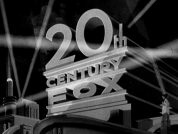 20th Century Fox logo (from "The Black Swan")20th Century-Fox Film Corporation - CLG Wiki20th Century Fox (1935, Colorized)20th Century Fox (1950)20th Century Fox (1967)20th Century Fox (1965)20th Century Fox (Colorized, 1940)
20th Century Fox logo (from "The Black Swan")20th Century-Fox Film Corporation - CLG Wiki20th Century Fox (1935, Colorized)20th Century Fox (1950)20th Century Fox (1967)20th Century Fox (1965)20th Century Fox (Colorized, 1940)
<iframe frameborder="0" height="150" src="http://wikifoundrytools.com/wiki/closinglogos/widget/unknown/1c9433f2fc5c63ca73e157eda11679406df507b2" width="199"></iframe><iframe frameborder="0" height="150" src="http://wikifoundrytools.com/wiki/closinglogos/widget/unknown/8cffebf33414b7ba2e2bf865adba23c0028330b4" width="199"></iframe><iframe frameborder="0" height="150" src="http://wikifoundrytools.com/wiki/closinglogos/widget/unknown/d8986223f3e4692458cf7099228a9971aed0fe87" width="199"></iframe><iframe frameborder="0" height="150" src="http://wikifoundrytools.com/wiki/closinglogos/widget/youtubevideo/5539015e61d4f85ff3850d38284a64cca4598b8f" width="206"></iframe>
 20th Century Fox logo (from "The Black Swan")20th Century-Fox Film Corporation - CLG Wiki20th Century Fox (1935, Colorized)20th Century Fox (1950)20th Century Fox (1967)20th Century Fox (1965)20th Century Fox (Colorized, 1940)
20th Century Fox logo (from "The Black Swan")20th Century-Fox Film Corporation - CLG Wiki20th Century Fox (1935, Colorized)20th Century Fox (1950)20th Century Fox (1967)20th Century Fox (1965)20th Century Fox (Colorized, 1940)<iframe frameborder="0" height="150" src="http://wikifoundrytools.com/wiki/closinglogos/widget/unknown/1c9433f2fc5c63ca73e157eda11679406df507b2" width="199"></iframe><iframe frameborder="0" height="150" src="http://wikifoundrytools.com/wiki/closinglogos/widget/unknown/8cffebf33414b7ba2e2bf865adba23c0028330b4" width="199"></iframe><iframe frameborder="0" height="150" src="http://wikifoundrytools.com/wiki/closinglogos/widget/unknown/d8986223f3e4692458cf7099228a9971aed0fe87" width="199"></iframe><iframe frameborder="0" height="150" src="http://wikifoundrytools.com/wiki/closinglogos/widget/youtubevideo/5539015e61d4f85ff3850d38284a64cca4598b8f" width="206"></iframe>
Nicknames: "The Searchlights II", "Fox Structure", "Majestic Tower II", "Futuristic Structure II"
Logo: It's the same as the 20th Century Pictures logo, except "FOX" appears in place of "PICTURES, INC.". This logo was once again designed by Emil Kosa, Jr.
Alternate Descriptive Video Transcription: Searchlights pierce a starry night sky, sweeping the clouds and illuminating a towering edifice in the form of "20th CENTURY FOX".
Variants:
- This logo first appeared in black and white, with a Technicolor version for color films debuting in 1936.
- On colorized prints, depending on how it was colorized, the logo would have different colors.
- The logo would either take place on a day or night sky.
- Fox Movietone News newsreels use a slightly altered version of the tower in the opening credits with "presents", in script, below it.
- For early color releases (except for The Little Princess), the structure is sepia-toned, the left searchlights are pink, the right searchlights are yellow and blue, the "stack" is blue, the middle searchlights are green, and the sky is dark purple.
- On the current print of Les Miserables, the logo fades into the NTA logo.
Closing Titles: Superimposed on a special background or sometimes on the last scene of a movie, fade in the words "The End" with fonts vary on the movie with the following text: "Released through Twentieth Century-Fox Film Corporation", "Released by Twentieth Century-Fox Film Corporation", "Produced and Released by Twentieth Century-Fox Film Corporation" or "Produced and Distributed by Twentieth Century-Fox Film Corporation".
FX/SFX: The searchlights in the background.
Music/Sounds: A redone variant of the 20th Century Pictures fanfare as composed and conducted by Alfred Newman once again, that has become one of the most famous pieces of music in the world.
Music/Sounds Variants:
FX/SFX: The searchlights in the background.
Music/Sounds: A redone variant of the 20th Century Pictures fanfare as composed and conducted by Alfred Newman once again, that has become one of the most famous pieces of music in the world.
Music/Sounds Variants:
- On Love Under Fire, a different recording of the fanfare is heard.
- On a few films, it is silent or has the film's respective opening theme.
- On some 20th Century Pictures films, the original TCP fanfare is heard due to sloppy plastering.
- Zorba the Greek, one of the last films to use this logo, use the first half of the 1953 CinemaScope fanfare.
- On the 1994 Studio Classics VHS of Carmen Jones, the 1979 fanfare was heard, likely due to a reverse plaster error.
- On Seven Arts TV prints, the full CinemaScope fanfare, with extension, is used (the extension is heard over the Seven Arts logo).
Availability: Very common. It's still saved on just about every 20th Century Fox release, with some exceptions. The color version can be seen on the 2007 DVD release of the 1939 version of The Little Princess (although some public domain prints of the film use the next logo, while other prints use either the black-and-white version or no logo at all) and some colorized prints of Bright Eyes and Heidi, as well as some newer colorized prints of Miracle on 34th Street. The logo premiered on Metropolitan and made its final (official) appearance on Prudence and the Pill, although the next logo premiered on The Robe. Some current releases of films such as The Blue Bird (1940), Leave Her to Heaven, Forever Amber, and David and Bathsheba in circulation plaster this logo with the next one. Older television prints of Return of the Fly plaster the next logo with this one, while retaining the CinemaScope fanfare, followed by the Seven Arts Television logo.
Editor's Note: The majestic fanfare and the unique design makes this one of the most iconic logos of all time.
2nd Logo
(September 16, 1953-December 11, 1987)
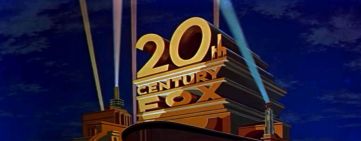 20th Century Fox (1968)20th Century Fox (1977)20th Century-Fox Film Corporation (1953)
20th Century Fox (1968)20th Century Fox (1977)20th Century-Fox Film Corporation (1953)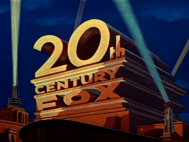 20th Century Fox (1979)20th Century Fox (1964)
20th Century Fox (1979)20th Century Fox (1964)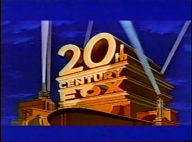
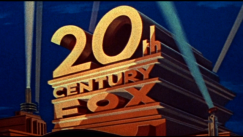 20th Century Fox - Straight Zero (1956)20th Century Fox (1963)
20th Century Fox - Straight Zero (1956)20th Century Fox (1963)
Nicknames: "The Searchlights III", "Fox Structure II", "Majestic Tower III", "Futuristic Structure III", "Slanted Zero"
Logo: A redrawn and more clearer version of the last logo, but the "0" on the top is crooked and two searchlights behind the tower have been removed. This logo was designed by Rocky Longo, who was an artist at Pacific Title and Art Studio, Inc. He also designed the next logo.
Trivia:
Editor's Note: The majestic fanfare and the unique design makes this one of the most iconic logos of all time.
2nd Logo
(September 16, 1953-December 11, 1987)
 20th Century Fox (1968)20th Century Fox (1977)20th Century-Fox Film Corporation (1953)
20th Century Fox (1968)20th Century Fox (1977)20th Century-Fox Film Corporation (1953) 20th Century Fox (1979)20th Century Fox (1964)
20th Century Fox (1979)20th Century Fox (1964)
 20th Century Fox - Straight Zero (1956)20th Century Fox (1963)
20th Century Fox - Straight Zero (1956)20th Century Fox (1963)CinemaScope (1956)Cinemascope (1954)Cinemascope (1956)20th Century Fox Film Corporation - CLG Wiki20th Century Fox - CinemaScope 55 (1956)
<iframe frameborder="0" height="150" src="http://wikifoundrytools.com/wiki/closinglogos/widget/unknown/b4e5be592737bb33b488075fb65a6b7289c530a7" width="266"></iframe><iframe frameborder="0" height="150" src="http://wikifoundrytools.com/wiki/closinglogos/widget/unknown/e8995fd7dd718b5bfad33851d6f24f96a9456c3b" width="266"></iframe><iframe frameborder="0" height="150" src="http://wikifoundrytools.com/wiki/closinglogos/widget/unknown/c89c27a1bb9f0ed77d3f5f5f250febba2339cb5c" width="266"></iframe><iframe frameborder="0" height="150" src="http://wikifoundrytools.com/wiki/closinglogos/widget/unknown/4792a4e3130e0090662d6ea9fc1d3892e8ae015e" width="266"></iframe><iframe frameborder="0" height="150" src="http://wikifoundrytools.com/wiki/closinglogos/widget/unknown/cb461cb728a3f3ab607ec6eaf489811175d7fafb" width="266"></iframe><iframe frameborder="0" height="150" src="http://wikifoundrytools.com/wiki/closinglogos/widget/unknown/deb5dee11c90096581dfef030d66a18dd6496d46" width="266"></iframe><iframe frameborder="0" height="150" src="http://wikifoundrytools.com/wiki/closinglogos/widget/unknown/884f95324385108ea0156c6f436c55f61c107b14" width="266"></iframe>
<iframe frameborder="0" height="150" src="http://wikifoundrytools.com/wiki/closinglogos/widget/unknown/ce0168f064b33e0e338302ff0f807f75fa3a83be" width="266"></iframe><iframe frameborder="0" height="150" src="http://wikifoundrytools.com/wiki/closinglogos/widget/unknown/12bca8cd04b33471a89bba6ba7af7a8cb092346d" width="266"></iframe>
Nicknames: "The Searchlights III", "Fox Structure II", "Majestic Tower III", "Futuristic Structure III", "Slanted Zero"
Logo: A redrawn and more clearer version of the last logo, but the "0" on the top is crooked and two searchlights behind the tower have been removed. This logo was designed by Rocky Longo, who was an artist at Pacific Title and Art Studio, Inc. He also designed the next logo.
Trivia:
- The extended CinemaScope fanfare has appeared in the two Star Wars 'original score' albums. Many other albums carry this fanfare (albeit rearranged). All of these albums can be found on iTunes.
- The second episode of The Simpsons 27th season, "Cue Detective", features the Cinemascope 55 "Regular 0" variant when Principal Skinner puts the 1967 version of Doctor Dolittle on for the children at Springfield Elementary. In typical biting-the-hand fashion, all the students shout "boo" when the Fox logo appears.
- The reason for the slanted "0" was to make the logo wide enough for its new aspect ratio.
Variants: The Fox logo has had many renditions over the years. Here are some of them:
- 1953-1967: The CinemaScope logo. The searchlights are slimmed down and the structure is placed in the center of the screen with a dark blue sky surrounding it. The logo fades to "TWENTIETH CENTURY-FOX PRESENTS A CINEMASCOPE PRODUCTION/PICTURE".
- 1956-1967: Large-format (70mm, CinemaScope 55) films used a different Fox structure where the "0" is not slanted. It made its first known appearance on Carousel.
- The one with the regular "0" also had this text: "A CINEMASCOPE PICTURE IN CINEMASCOPE 55". In 1961, The King and I was re-released in a 70mm version, called "GRANDEUR 70".
- 1960-1965: For movies that were shot in 70mm/Todd-AO, such as 1960's Can-Can, 1963's Cleopatra, and 1965's The Agony and the Ecstasy, the 20th Century Fox logo with the regular "0" appears for five seconds and then fades to the words "TWENTIETH CENTURY-FOX PRESENTS". The Bible (1966) contains the text "A TWENTIETH CENTURY-FOX RELEASE" with copyright information below it.
- 1957-1987: Like the slanted zero version of CinemaScope logo, but without the snipe and fades out.
- 1956-1967: Like the standard zero logo, but does not have the snipe and fades out.
- There is an extended version of the 1953-1987 logo without the CinemaScope logo. It appeared only on two films, 1977's High Anxiety and 1981's History of the World, Part I, both directed by and starring Mel Brooks. The logo loops in reverse like the next logo.
- 1968-1987: The structure and the sky background are off-center and shifted to the left. Starting in 1976 with The Omen, the registered trademark symbol "®" was added to the bottom of the logo.
- There was a short version of this logo.
- The logo would take place on either a day or a night sky.
- On older international prints of Chariots of Fire and Breaking Away (and a recent TV airing of the former film), the logo is zoomed in, because those films were shot in "open matte" and the logo was not adjusted for widescreen.
- On Quintet, the logo fades to a white snowstorm, revealing the start of the movie.
- An ultra dark variant due to film deterioration exists. Such films that have this variant are older prints of The Omen.
- There is an deteriorated variant that shakes only once.
- Some letterboxed widescreen variants have background colors filling in the empty screen space. Some early 2000's HBO widescreen airings have a blue fill. The 1992 Fox Video VHS of M*A*S*H has a green fill color.
Closing Titles:
- 1953-1965: Same as above, but the "The End" words were moved to the very top and the 20th Century-Fox text is pushed to the bottom to give space for the text "A CINEMASCOPE PRODUCTION" or "A CINEMASCOPE PICTURE".
Music/Sounds:
- November 5, 1953-1960: The 1953 recording of the original fanfare, which debuted on How to Marry a Millionaire.
- April 30, 1954-1967: The original fanfare is extended for CinemaScope, as conducted by Alfred Newman and debuted on River of No Return; after CinemaScope was dropped in 1967, the 1935 fanfare is only used from this point on, until it returned on Star Wars in 1977.
- March 9, 1960: A different recording of the original fanfare, conducted by Nelson Riddle, debuted on Can-Can.
- 1965-October 31, 1981: The 1935 recording of the original fanfare.
- 1979?-December 11, 1987: A re-orchestrated version of the 1935 fanfare. The earliest known film to have used this fanfare is believed to be Scavenger Hunt. This arrangement is used on the next logo.
- May 17, 1980- : A new recording of the fanfare, played by the London Symphony Orchestra and conductor John Williams, which debuted on (Star Wars Episode V) The Empire Strikes Back.
- In other cases, it is silent or has the movie's opening theme.
Music/Sounds Variants:
- Marilyn Monroe's final and unfinished project Something's Got to Give (1962) has the short, slowed-down version of the 1997 fanfare (re-orchestrated a la '07 TCFTV's fanfare). The film can be found as a bonus feature on The Seven Year Itch special edition DVD.
- Logan: Noir Edition uses the full, unabridged 1997 fanfare.
- An abridged remix of the 1954 CinemaScope fanfare, beginning with 0:03-0:04 of the fanfare, then 0:05-0:09 and finally 0:18-0:23. This can be heard on quite a few films, such as Fire Sale, Damien: Omen II, Brubaker, Fatso, Willie & Phil, the 1973 TV movie Miracle on 34th Street, the 1977 TV movie Good Against Evil, and the 1980 TV movie The Diary of Anne Frank.
- There is also a slightly modified version of the 1954 CinemaScope extended fanfare, used on Star Wars (later known as Star Wars: Episode IV - A New Hope), released in 1977. It has an echo-like effect and sounds slightly re-orchestrated.
- High Anxiety, also released in 1977, had a slightly modified version of the 1954 CinemaScope fanfare that sounded like a combination of the regular 1954 fanfare and the modified version from Star Wars and is also reverberated (noticeable at the tail end of the fanfare right before the opening credits).
- History of the World, Part I, released in 1981, has a different re-orchestration of the CinemaScope extended fanfare.
- There are low toned versions of the 1935 and 1954 CinemaScope fanfares that exist on some films.
- Older prints of 1935's The Call of the Wild have the 20th Century Pictures fanfare.
- Recent prints of The Roots of Heaven play the 1994 fanfare over the CinemaScope variant.
- The original 1977 Magnetic Video release of Fantastic Voyage has the opening flourish of the Magnetic Video music mistakenly play back during the first half of the fanfare.
- Netflix prints of French Connection II use an abridged recording of the John Williams 1980 rendition of the CinemaScope extension (1999 orchestration).
- The VHS of Young Guns II has this logo with the 1979 music playing over it instead.
- On a copy of "La Loca Historia del Mundo" this logo surprisingly has the Gaumont music from 1981! This is mainly due to logo plastering and the logo can be seen <a href="https://www.youtube.com/watch?v=Qs7OBhwkOzk" target="_self">here</a>
Availability:
- Very common. It's still retained on just about every 20th Century Fox release,starting with The Robe, the first film to use this logo.
- The CinemaScope variants aren't usually subject to plastering, however one print of Satan Never Sleeps that aired a decade ago on AMC plastered it with the 4th logo, but is retained on DVD releases of said film and a FMC airing.
- Some films from the era such as Star Wars (Episode IV: A New Hope) and Star Wars: Episode V - The Empire Strikes Back were also seen with this logo (which are kept on the original theatrical versions on the 2006 DVD releases of said films), but replaced with the 4th logo on all Special Edition versions.
- The International version of Chariots of Fire also originally had this logo, but plastered it with the 1994 logo on the current UK DVD release. However, it was intact on a recent TV airing on SKY and the Warner Blu-ray of the International version.
- The original VHS releases of Moving Violation (1976) and Thunder and Lightning by Key Video updated it with the 3rd logo; the former restored it on current prints and the Shout! Factory DVD, while the latter still plasters it but keeps the original abridged fanfare.
- Some releases of Alien and its Director's Cut version plaster it with the 3rd logo, though the first 1981 VHS, 1999 theatrical DVD, and the newest Blu-ray retain it.
- This logo possibly made its final official appearance on Wall Street,though all current prints update it with the 3rd logo. It is unknown if it originally appeared on theatrical prints as well.
- This logo can also be found some early-mid '80s films of the era, such as The Cannonball Run (variant), older video releases of Bill Cosby: Himself (1983), the original CBS/Fox Video release of Revenge of the Nerds (1984), the original Key Video VHS of The Buddy System (1984), Moving Violations (1985), the CBS/Fox VHS of Project X (1987), older cable prints of Young Guns (1988) and older VHS copies of Young Guns II (1990), though the latter film's letterbox LaserDisc release used the third logo. These aforementioned were some of the few films from their respective years to use this logo. Sadly, most home video/DVD releases and TV prints of these films plaster it with the either the 3rd logo or those from another distributor.
- Current prints of Avalanche Express (a Lorimar film they distributed, which WB now owns due to the purchase of the former's library) plaster it with the current WB shield, but is intact on the Spanish R2 DVD.
- The logo was not seen at all on Carmen Jones, The Girl Can't Help It, A Circle of Deception, The Longest Day, Zorba the Greek, Those Magnificent Men in Their Flying Machines, Batman: The Movie, The Cape Town Affair, The Day the Fish Came Out, Star!, Deadfall, Patton (some TV broadcasts spliced in the logo from another film), Tora! Tora! Tora!, Trouble Man, The Poseidon Adventure, USA prints of The Towering Inferno (as Fox owns primary North American distribution rights, while Warner Bros. owns most international rights, though both companies worked on the film together), At Long Last Love, The Adventure of Sherlock Holmes' Smarter Brother, Silent Movie, and All This and World War II.
- The "regular 0" variant without the CinemaScope snipe or "Twentieth Century-Fox presents" card following is seen on The Sound of Music, and the original 1967 Doctor Dolittle.
- The 1976 revision makes a very strange appearance on the Criterion Collection Blu-ray of Naked Lunch (a 1991 film).
- Appears on the Vestron VHS of Fort Apache: The Bronx (despite not mentioning TCF on the cover) and Trifecta's airing of Oh Heavenly Dog!
- Southern Comfort was originally seen with the 1976 revision of this logo before the Cinema Group ident; it can be seen on some older European copies, preceded by the Overseas Filmgroup logo.
- It also plasters the 2009 logo on Logan: Noir Edition.
Editor's Note: The tilted zero can be an eyesore to look at for some, but it's still a majestic logo.
3rd Logo
(August 28?, 1981-August 5, 1994)
20th Century Fox - CLG Wiki20th Century Fox (1981-1994)20th Century Fox (1982)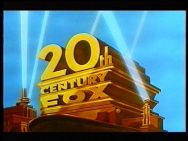 20th Century Fox (1983)20th Century Fox (1983, Variant)20th Century Fox (1985)20th Century Fox (1988, Widescreen)
20th Century Fox (1983)20th Century Fox (1983, Variant)20th Century Fox (1985)20th Century Fox (1988, Widescreen)
 20th Century Fox (1983)20th Century Fox (1983, Variant)20th Century Fox (1985)20th Century Fox (1988, Widescreen)
20th Century Fox (1983)20th Century Fox (1983, Variant)20th Century Fox (1985)20th Century Fox (1988, Widescreen)<iframe frameborder="0" height="150" src="http://wikifoundrytools.com/wiki/closinglogos/widget/unknown/d0bf0845d8442b8286607c3edce2a7c33714cdbe" width="266"></iframe><iframe frameborder="0" height="150" src="http://wikifoundrytools.com/wiki/closinglogos/widget/unknown/aa89450c0bb35580a082f179feaade2fde3b61d6" width="266"></iframe>
Nicknames: "The Searchlights IV", "Fox Structure III", "Majestic Tower IV", "Futuristic Structure IV", "Pre-Ultra Majestic Tower"
Nicknames: "The Searchlights IV", "Fox Structure III", "Majestic Tower IV", "Futuristic Structure IV", "Pre-Ultra Majestic Tower"
Logo: Another redrawn version of the last logo. This time, the structure is as off-center left as the late 1960s variant of the 1953 logo. This logo was designed when Rocky Longo repainted the eight-layered glass panels, and straightened the zero. This design of the logo still continues to this day (albeit in a slightly modified form).
Variants:
- On some films, such as Porky's Revenge!, the front-left searchlight is pink.
- Some films used a dark, washed-out structure.
- On widescreen (letterbox) films, the Fox logo would be squeezed to fit on standard 1.33:1 film and then stretched with special projector lenses so it could be shown in widescreen (2.35:1), though the first two Die Hard films use a version where the logo is not squeezed, and thus is stretched out horizontally.
- There is another scope variant that was done for films shot in Super 35 where the 1.85 variant was cropped to 2.35.
- On a few films shot in scope, the logo is in extreme close-up.
- On a couple films, the logo is placed at a very far distance.
- A black & white version of this logo exists.
- A 4:3 anamorphically-squished version was used on the 1989 CBS/Fox video release of Die Hard and the TV spots for The Fly (1986 remake).
Closing Titles: Same as the previous, but the text reads as either: "Produced and Released by Twentieth Century Fox Film Corporation" or "Released by Twentieth Century Fox Film Corporation". In 1990, the text was shortened to either "Released by Twentieth Century Fox" or "Produced and Released by Twentieth Century Fox." On The Abyss and My Cousin Vinny, there was a variation which had "RELEASED BY" and below the 20th Century Fox print logo.
FX/SFX: The searchlights in the background. One should note that the searchlights usually do particular movements. 2 right searchlights line up in the back while the left back light moves away to the left. While the 2nd right back light leans further to the right, either of these crosses between the first 2 back searchlights occurs: an "A" cross, a "slanted A" cross, or a "slanted X" cross. They're often looped/reversed.
Music/Sounds:
FX/SFX: The searchlights in the background. One should note that the searchlights usually do particular movements. 2 right searchlights line up in the back while the left back light moves away to the left. While the 2nd right back light leans further to the right, either of these crosses between the first 2 back searchlights occurs: an "A" cross, a "slanted A" cross, or a "slanted X" cross. They're often looped/reversed.
Music/Sounds:
- August 28?, 1981-October 1, 1993: The 1979 fanfare, last heard on Freaked. This was used in tandem with the long version until that year; most films would either use the long version, have it silent, or with the film's opening theme.
- August 6, 1982-July 1, 1994: A re-orchestration of the long version of the 20th Century Fox fanfare, as conducted by Lionel Newman. The first film to use this rendition was The Pirate Movie and the last to use it was Baby's Day Out.
- In other cases, silence or the film's opening music.
Music/Sounds Variants:
- On some films, such as Porky's II: The Next Day, the 1935 fanfare is heard.
- Some prints of pre-1981 films, such as Thunder and Lightning, are plastered with this logo, but keep their original fanfare or sometimes use the 1979 variant. In some cases it is silent, like on Hardly Working, or have the opening theme to the film.
- In 1983, a slightly modified 1980 recording/re-orchestration, as played by the London Symphony Orchestra and conductor John Williams, was used on (Star Wars Episode VI) Return of the Jedi. Similarly Class Action & War of the Roses use James Horner's own re-orchestration; some Jerry Goldsmith films also use his own re-orchestration. A strange re-orchestration of the Alfred Newman fanfare with a heavy brass section was used on The Chase.
- The DVD release of Caravan of Courage: An Ewok Adventure, and the French audio track on the 1998 DTS DVD of Predator use the 1997 orchestration.
- On the 1986 remake of The Fly, the abridged remix of the 1953-67 CinemaScope fanfare is surprisingly heard, possibly on purpose.
- On Wizards, the logo is out of sync with the 1979 fanfare.
- On AMC's prints of Wall Street, a low pitched version of the 1979 fanfare is heard.
Availability: Very common.
- Notable films to use this logo are Taps, The Verdict, theatrical versions of Star Wars Episode VI: Return of the Jedi, Porky's II: The Next Day, Porky's Revenge!, Commando, Aliens, Predator, Broadcast News, Big, Die Hard, Predator 2, Home Alone, Die Hard 2, Home Alone 2: Lost in New York, Alien 3, Speed, and Baby's Day Out, among others.
- It allegedly premiered on Chu Chu and the Philly Flash,and appears on VHS copies of said film, but there are theatrical copies in existence with the previous logo. This logo made its final appearance on Airheads, while the next logo debuted on True Lies.
- This also plasters the 2nd logo on full frame VHS releases of Star Wars (Episode IV: A New Hope) from 1982 to 1992 (it was retained on the film's <a href="https://www.youtube.com/watch?v=Le_JlSG-5jM" target="_self">HBO prem</a><a href="https://www.youtube.com/watch?v=Le_JlSG-5jM" target="_self">iere in 1983</a> and widescreen releases of the film on VHS and laserdisc in 1989, 1992 and 1993. It was reinstated to the full frame version in 1995 on VHS) and current prints of Thunder and Lightning (with the abridged CinemaScope fanfare), Wizards, the Director's Cut of Alien, My Bodyguard, Revenge of the Nerds, Bad Medicine, Moving Violations (1985), Wall Street, and Revenge of the Nerds II: Nerds in Paradise.
- Fox plastered/updated the 2nd logo with this on some colorized versions of its films in the 1980s, such as Miracle on 34th Street (although its original logo is restored on newer colorized prints), and Technicolor films such as Halls of Montezuma.
- It is unknown if this logo is seen on theatrical international prints and home video of Street Fighter II: The Animated Movie from its release on August 6.
- This can also be seen on international prints of Crocodile Dundee (and on Australian prints of Crocodile Dundee 2) and Teenage Mutant Ninja Turtles II: The Secret of the Ooze (which surprisingly appeared on a bootleg Blu-Ray) & III, as well as the trailer for Deck the Halls.
- When History of the World: Part I (one of the last films to use the 2nd logo) aired on AMC in the mid-2000s, the extended version of this logo popped up at the very end; recent airings on AMC now use the current 20th Television logo instead.
- Post-2007 releases of Die Hard 2 update this with the 1997 logo.
- The Hong Kong 1995 P&S LD of Star Wars: Episode VI - Return of the Jedi removes this in favor of CBS-FOX Video.
- The B&W variant, though extremely rare, appears on some American prints of The Sicilian (don't expect to see this on the Vestron Video VHS).
- The 1991 (not 1989) Vestron Video release of Young Guns, including the late '90s LIVE reprint which uses that master, plastered the TCF logo with a sped-up silent version of the Vestron Pictures logo, while other prints omit the logo.
- Other Fox releases of Morgan Creek movies have this logo removed on Media Home Entertainment releases and current prints, but is retained on the CBS/Fox Video/Fox Video releases of The Exorcist III, Young Guns II and Pacific Heights and TubiTV's print of Nightbreed (the theatrical cut).
- Older VHS and DVD copies of Speed have this logo plastered over with the next one; However, it's retained on the Blu-Ray.
- IVE's releases, along with DVDs from Live Entertainment and Artisan Entertainment, of films from Gladden Entertainment Corporation generally preserved this logo, but it was removed on the 1991 release of Mannequin 2: On the Move by Live Home Video, the Blu-Ray of Millennium (1989) from Shout! Factory, the Olive Films Blu-Ray releases of Mannequin and Mannequin 2: On the Move,and the 1996 re-release of Weekend at Bernie's by Avid Home Entertainment. It's also preserved on the Vestron Video VHS and Shout! Factory Blu-ray of The Sicilian.
- It is believed that international theatrical prints of Brazil had this logo, but most home video releases go straight to the opening title card while the Fox Blu-Rays have the 1994 logo.
- Most U.S. home video releases of The Princess Bride do not have this logo, with the exception of the 1998 MGM VHS, as they only have North American television and theatrical rights and as a result, it can be seen on U.S. TV prints of said film.
Editor's Note: A return to the more accurately drawn Fox tower. This would serve as a template for the next logo below.
4th Logo
(July 15, 1994-October 5, 2010, March 30, 2013)
<iframe frameborder="0" height="166" src="http://wikifoundrytools.com/wiki/closinglogos/widget/genericvideo/cfa651e67cdc028247b6167bd43ba82fae4f3eca" width="295"></iframe><iframe frameborder="0" height="166" src="http://wikifoundrytools.com/wiki/closinglogos/widget/genericvideo/3b1584b63f95627aaac836f3538a9f44d6267953" width="295"></iframe><iframe frameborder="0" height="167" src="http://wikifoundrytools.com/wiki/closinglogos/widget/unknown/be620d65da95b9db826f8be2ee1f1b31e8494d52" width="296"></iframe>
Nicknames: "CGI Searchlights", "Ultra Majestic Tower", "The Searchlights V", "Futuristic Structure", "Majestic Tower V", "Futuristic Structure V", "Fox Structure IV"
Logo: We start on a black background. Then two searchlights swoop across the screen, revealing a top aerial view of the 20th Century Fox structure, redone in CGI. The camera pans down and then across the logo, revealing the starry and cloudy blue/purple/orange Los Angeles and Hollywood evening skyline in the distance, before settling into its more customary position and angle. The byline "A NEWS CORPORATION COMPANY" fades in at the bottom of the screen. The structure looks similar to the 1981 logo.
Trivia:
- If one looks very close in the far right-hand corner before approaching the main structure, one can see the Hollywood sign. It is not very big, but it is visible if one looks hard enough. Also, if you look hard enough, you can see stars in the BG at the end of the logo.
- This logo was designed by Kevin Burns and animated at Studio Productions (now known as "Flip Your Lid Animation"), who also animated the 1990-1997 Universal logo and the 1986-2003 Paramount logo. The design was used earlier for the 1992 20th Television logo.
- If you look very closely (especially if you're watching it in HD), you can see the names of fictional restaurants/stores behind the structure, such as "Steve's Place", "Great Treasure", "Burns Tri-City Alarm", and "Chernin's".
Variants:
- There is a prototype version of this logo where the rear searchlights animate differently and the front-right searchlight leans further left. Also, the aforementioned Hollywood sign is located directly behind the structure and the Hollywood hills behind the cityscape look different. This version appeared on a demo reel from Flip Your Lid Animation.
- On the "Special Edition" remastered versions of the Star Wars trilogy from 1997 onward and the Star Wars prequel trilogy, there is no camera panning; it just remains in its usual place until it fades to the Lucasfilm Ltd. logo, which is shown over the CinemaScope music extension.
- A short version of this logo appears on The Making of The Pagemaster and the CBS television special I Walk the Line: A Night for Johnny Cash.
- There is an unedited open matte version with neither the byline nor the "®" symbol. It also runs at a smoother framerate, because it wasn't transferred to film yet. While this variant isn't used on any films or programming, the ending of it was used for the box on the 1995-2008 20th Century Fox Home Entertainment logo. It was found on a different version of a Flip Your Lid Animation demo reel and at the end of 20th Century Fox: The First 50 Years.
- Open matte and bylineless versions exist.
Closing Titles:
- Same as the last logo until 2006.
- On Titanic, the text reads as: "Produced and Released by Twentieth Century Fox and Paramount Pictures".
- On The Magic Pudding, the print logo is seen instead of the "Twentieth Century Fox" text alongside the Icon Productions and Energee Entertainment print logos.
FX/SFX: The panning of the camera across the Fox structure, the moving searchlights, and the News Corporation byline fading in.
Music/Sounds:
Music/Sounds:
- July 15, 1994-January 30, 1998: A <a href="https://www.youtube.com/watch?v=Xm2VKrlClPg" target="_self">re-orchestration</a> of the long TCF fanfare, as conducted by Bruce Broughton in the same stage that the original 1935 fanfare was recorded in. The orchestra is 3 times bigger and the fanfare has more reverberation/echo, and larger brass and string sections than other TCF fanfares. The last release (officially) to use this fanfare was Great Expectations. However, Wing Commander, released on March 12, 1999, some prints of Lake Placid 2, released in 2007, and on German productions, such as Krabat (released on October 9, 2008) and John Rabe (released April 2, 2009), used this fanfare instead of the 1997 fanfare for some reason.
- November 14, 1997, March 27, 1998- : A slightly slower re-orchestration of the long TCF fanfare, as performed by the 20th Century Fox Studio Orchestra conducted by David Newman, whose father Alfred Newman composed the original fanfare in 1933, as well as its extended counterpart in 1954. The first movie to use this fanfare was 1997's Anastasia. After the release of Anastasia, Fox films kept using the 1994 fanfare until January 1998.
Music/Sounds Variants:
- The "Special Edition" version of The Star Wars Trilogy uses the modified 1954 recording of the fanfare as played by the 20th Century Fox Studio Orchestra and conductor Alfred Newman, and the 1980/83 recording of the fanfare as played by the London Symphony Orchestra and conductor John Williams, respectively. Re-orchestrations of John Williams' fanfare were used on the Star Wars prequel films.
- On The Legend of Baggar Vance and most international prints of Braveheart, the opening theme of the movie is heard over the logo.
- On the Australian, New Zealand and UK releases of Shine a Light, the logo is silent.
- There is a short version of the 1997 fanfare. The only films to use it are The Darjeeling Limited with the short version of the Fox Searchlight Pictures logo and Marilyn Monroe's unfinished project Something's Got to Give (1962) with the 2nd logo.
- On some prints of Speed and the first two Die Hard films, the 1981-1994 fanfare is heard due to plastering the 3rd logo. Other prints may use the 1994 or 1997 fanfares.
Availability: Very common. First seen on True Lies, and in front of almost every subsequent 20th Century Fox film from this time period up to Tooth Fairy. Surprisingly, this also appears on some trailers, behind-the-scenes clips and interviews for Predators, as well as the international trailer for Vampires Suck, in tandem with the new logo. Also appears on some video games based on 20th Century Fox films. This logo was used in tandem with the next logo until mid-2010, and seen on direct-to-video releases of that year such as Flicka 2, Mirrors 2, and Space Chimps 2: Zartog Strikes Back, among others. It plasters the 2nd logo on international DVD releases of Chariots of Fire as 20th Century Fox holds distribution rights. This makes a strange re-appearance on the Toei Animation production Dragon Ball Z: Battle of Gods (2013), and still remains unchanged on the U.S Funimation DVD and Blu-ray release. It was also surprisingly preserved on the American DVD release of The Wiggles Movie, where it was retitled Magical Adventure! A Wiggly Movie, despite the U.S. DVD being from HiT Entertainment. On newer prints of some pre-1997 films (an example being Neil), the 1994 fanfare is replaced by the 1997 one. On digital copies of Star Wars Episodes V-III, the Fox logo is removed and only shows the Lucasfilm logo with a custom Star Wars theme, as this is likely due to Disney's ownership of the latter since 2012. However, following Disney's purchase of the studio, recent Disney+ prints have the logo restored (excluding the registered trademark symbol and News Corporation byline).
Editor's Note: This logo had amazing CGI that still holds up decently well, and it ultimately became a favorite of many logo fans.
5th Logo
(December 10, 2009-January 10, 2020)
5th Logo
(December 10, 2009-January 10, 2020)
20th Century Fox (2009)20th Century Fox (2010)Celebrating 75 Years of 20th Century Foxfox201120th Century Fox (2009)20th Century Fox Film Corporation - CLG Wiki20th Century Fox (2013)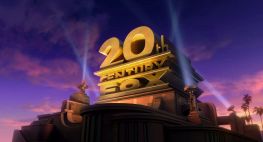
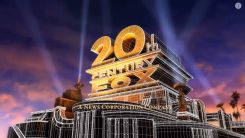


<iframe frameborder="0" height="150" src="http://wikifoundrytools.com/wiki/closinglogos/widget/unknown/5d7e3dc15c3d9510581cfb1d4894b60e7b414691" width="266"></iframe>
Nicknames: "CGI Searchlights II", "Ultra Majestic Tower II", "The Searchlights VI", "Majestic Tower VI", 'Fox Structure V", "Decade Tower", "2010 Fox", "20th's 75th", "Happy Anniversary, Fox!" "Happy 75th, 20th!", "2010s Tower", "75 Years of 20th Century Fox"
Logo: It's a redone and more realistic version of the 1994 tower. This time, it is in a dark/orange evening environment. When the structure is in its distance, we can see an extra searchlight and a pair of palm trees on the bottom right hand corner. This structure, like the 1994 structure, also looks similar to the 3rd logo. This logo was designed by Chris Wedge and Carlos Saldanha and was animated at Blue Sky Studios, 20th Century Fox's sibling company and creator of Ice Age.
Trivia: This logo debuted on a trailer for Avatar on August 20, 2009 for the very first time. Afterwards, the logo first appeared on the aforementioned film, released on December 18, 2009 (though earlier premiering in London on December 10, 2009). Like the previous logo, if one looks very close in the far right-hand corner before approaching the main structure, one can see the Hollywood sign (not very big, but still visible if one looks hard enough). One can also see stars at the end of the logo, but there are fewer than the previous logo. The "Celebrating 75 Years" variant for TCF's 75th anniversary is a well done contemporary throwback of--and a contemporary homage to--the 20th Century Fox CinemaScope logo, where the 20th logo faded after 10 seconds into the CinemaScope logo. Surprisingly, this has made an appearance on a season 3 episode of This Is Us.
Bylines:
- December 10, 2009-June 28, 2013: "A NEWS CORPORATION COMPANY"
- July 17, 2013-January 10, 2020: Bylineless
Variants:
- For the logo's first official year (2010, even though the logo actually debuted in 2009), while the logo finishes its move into position, the camera pans up and two streaks of light draw "75" with the word "CELEBRATING" above the numbers and "YEARS" below both in spaced-out letters. The camera pans the words and numbers in position. Also, the Registered trademark symbol "®" and the News Corporation byline are engraved on different parts of the structure.
- The prototype version had a much darker red-orange sunset sky, harder shading, and different searchlight positions.
- Another prototype version appears on two CGI environment reels by Dave Strick, a designer at Blue Sky Studios. The searchlights are less realistic, the front-left searchlight is located in a slightly different position and wireframes fade in on most of the 3D geometry at the end of the logo sequence. One version of this has Blue Sky's logo and copyright info (dated to 2008) along the bottom of the screen, while another version has details (including Strick's email address) at the beginning where the logo starts blurry and then gains focus. This version can be seen <a href="https://www.youtube.com/watch?v=ZsWli-PP3GM" target="_self">here</a> and <a href="https://www.youtube.com/watch?v=f6IzE6WCdvA" target="_self">here</a>.
- A short version with the final seconds of the animation appears on licensed video games, such as Rio: The Video Game, Aliens vs. Predator and Ice Age: Continental Drift.
- The final half of this logo's camera-panning sequence can be seen at the beginning of Star Wars Episode I: The Phantom Menace 3D (before the Lucasfilm logo).
- Starting with the release of Turbo on July 17, 2013, the News Corporation byline is excluded and the logo is bylineless for the first time since the 3rd logo, due to the aforementioned split on June 28, 2013.
- An open matte version exists.
Closing Titles: For the most part, none. There are a few closing variants, however:
- A short version (with very subtle camera pan) is seen at the end of Lincoln and the 2015 remake of Poltergeist, DreamWorks Animation films starting with The Croods, and Ice Age: A Mammoth Christmas (TV airings only). Surprisingly, it's also seen on The Simpsons short film The Longest Daycare as an opening logo. A bylineless version appears at the end of Ice Age: The Great Egg-scapade.
- At the end of Star Wars: Episode I - The Phantom Menace 3D, the text "Released by Twentieth Century Fox Film Corporation" is shown.
- At the end of Parental Guidance, the print logo is shown.
FX/SFX: Same as before.
Music/Sounds: The 1997 fanfare, same as the one from the previous logo.
Music/Sound Variants:
Music/Sounds: The 1997 fanfare, same as the one from the previous logo.
Music/Sound Variants:
- The 2007 recording of the 1989 20th Century Fox Television fanfare was heard at the end of Ice Age: A Mammoth Christmas.
- The 1999 recording of the 1980 re-orchestrated fanfare, as conducted by John Williams and played by the London Symphony Orchestra, was retained at the beginning of Star Wars: Episode I - The Phantom Menace 3D when the final half of 20th's current logo animation was seen, followed by the Lucasfilm logo.
- The 1994 fanfare was heard on international prints of Titanic, beginning with the 2012 3D re-release.
- The 1981 fanfare was heard on the 3D version of Predator.
- In rare cases, such as on US prints of The Monuments Men as well as Ad Astra, the film's opening music plays over the logo.
- In very rare instances, such as Bridge of Spies, the logo is silent.
- The 2012 recording of the 1989 20th Century Fox Television fanfare was heard at the end of Ice Age: The Great Egg-scapade, though it's slightly quieter and has a small amount of echo at the end.
Availability: Very common. First appeared on Avatar, and the trailer for Aliens vs. Predator (PS3/XBOX 360). The prototype versions are found on the trailers and TV spots for Avatar, as well as various newer 20th Century Fox games. This logo with the phrase "Celebrating 75 Years" and an engraved News Corporation byline officially first appeared on Percy Jackson & the Olympians: The Lightning Thief, released on February 12, 2010, and was seen for the last time on Gulliver's Travels, released on December 25, 2010. Also appears on most international theatrical releases of Metro-Goldwyn-Mayer films, starting with Hot Tub Time Machine. Also appears on some video games based on 20th Century Fox films. The last film to use this logo with the News Corporation byline was The Heat, released on June 28, 2013. Also appears on international prints of Yours, Mine & Ours (2005 remake). From 2013 to 2018, it was seen at the start of DreamWorks Animation films before the 2010 DreamWorks Animation logo, beginning with The Croods and ending with Captain Underpants: The First Epic Movie. Newer releases may plaster this logo with the Universal Pictures logo. This additionally plasters the previous logo on Star Wars I: The Phantom Menace (3D prints only) and international prints of Titanic since 2012, and the 1981 logo on Predator (3D prints only) since 2013. The final film to use this logo was Underwater, due to the rename of the studio dropping the "Fox" in the name (mostly due to people associating TCF with other Fox properties, most notably Fox News Channel, which is no longer under common ownership with the studio).
Editor's Note: It's a suitable successor to 20th Century Fox's original CGI searchlights.
_______________________________________________________________
20th Century Studios
20th Century Studios
Background: In December 2017, Disney announced its plans to buy most of 21st Century Fox's assets, which included a bidding war with Comcast; the acquisition process was completed on March 20, 2019, with the last pre-Disney release from the studio being Alita: Battle Angel, released on February 14, 2019. The remaining assets Disney didn't acquire, notably the Fox network and Fox News, were spun-off into a new company called Fox Corporation. In January 2020, Disney announced that it would be dropping the word "Fox" from the company name, presumably to avoid confusion with Fox Corporation, renaming it as "Twentieth Century Studios." However, the studio is still legally incorporated and traded as 20th Century Fox.
(February 21, 2020- )
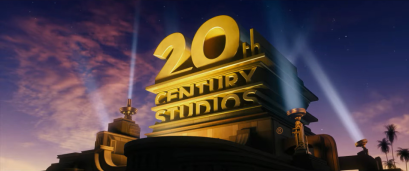 <iframe frameborder="0" height="167" src="http://wikifoundrytools.com/wiki/closinglogos/widget/genericvideo/7bfdf18088ce5e7beb62d648f67f2a8e2ce8c5c2" width="298"></iframe>
<iframe frameborder="0" height="167" src="http://wikifoundrytools.com/wiki/closinglogos/widget/genericvideo/7bfdf18088ce5e7beb62d648f67f2a8e2ce8c5c2" width="298"></iframe>
 <iframe frameborder="0" height="167" src="http://wikifoundrytools.com/wiki/closinglogos/widget/genericvideo/7bfdf18088ce5e7beb62d648f67f2a8e2ce8c5c2" width="298"></iframe>
<iframe frameborder="0" height="167" src="http://wikifoundrytools.com/wiki/closinglogos/widget/genericvideo/7bfdf18088ce5e7beb62d648f67f2a8e2ce8c5c2" width="298"></iframe>null space
Nicknames: "CGI Searchlights III", "Ultra Majestic Tower III", "The Searchlights VII", "Majestic Tower VII", "Decade Tower II", "2020s Tower"
.
Logo: Nearly the same as the final 20th Century Fox logo, except "FOX" is replaced with "STUDIOS", and "CENTURY" is slightly taller to accommodate for it. The logo has also been enhanced with more realistic lighting and textures, a different sky backdrop, sleeker looking searchlights, and a larger and more detailed Los Angeles cityscape.
.
FX/SFX: Same as before.
Music/Sounds: The 1997 Fox fanfare, same as before.
Availability: First seen on a TV spot for The Call of the Wild and made its official debut on said film.
Editor's Note: It's quite a nice update to the last Fox logo, although it can be somewhat hard trying to get used to the name change.
